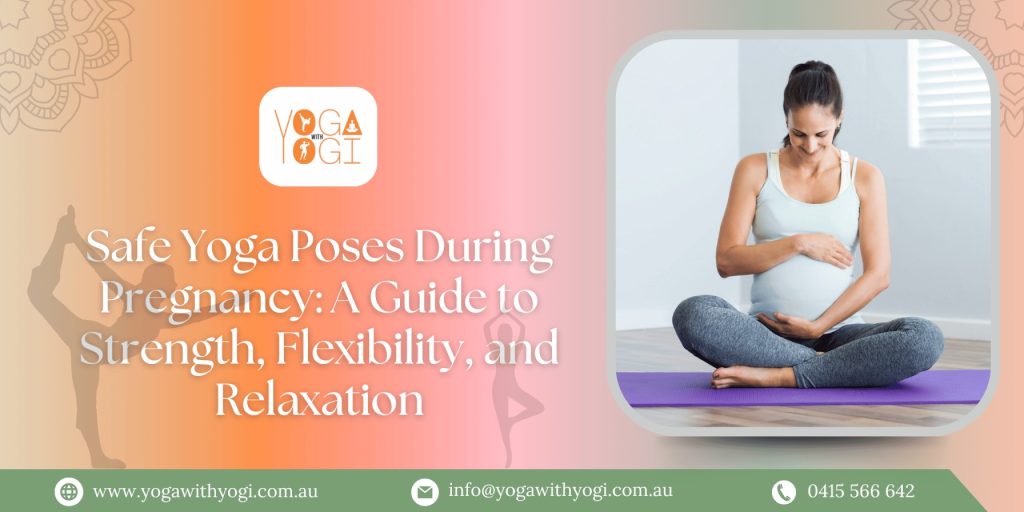Pregnancy is a beautiful, transformative time in a woman’s life, and maintaining physical health during this period is crucial. Yoga is an excellent way to stay active, enhance flexibility, and promote relaxation during pregnancy. However, it’s important to practice safe yoga poses during pregnancy that are specifically designed to cater to the changing body and avoid any potential harm to both the mother and the baby.
If you’re looking for prenatal yoga classes that focus on safe practices during pregnancy, consider checking out Prenatal Yoga Classes, where experienced instructors can guide you through the safest and most beneficial poses for each trimester.
The Benefits of Yoga During Pregnancy
Yoga is a great way to support both physical and mental well-being during pregnancy. Practicing yoga can help:
- Reduce stress and anxiety through relaxation and breathing techniques
- Increase flexibility in preparation for childbirth
- Improve posture and alleviate back pain, which is common during pregnancy
- Build strength in the muscles needed for labor and delivery
- Enhance circulation and prevent swelling
- Promote better sleep
However, it’s essential to understand which poses are safe and beneficial for both mother and baby throughout the pregnancy journey.
Safe Yoga Poses for Each Trimester
First Trimester (Weeks 1–12)
During the first trimester, your body is just beginning to adapt to pregnancy. The focus should be on gentle stretches and improving circulation without putting too much pressure on your body.
- Cat-Cow Pose (Marjaryasana-Bitilasana)
- Benefits: Helps alleviate back pain and improves spinal flexibility.
- How to do it: Begin on your hands and knees in a tabletop position. As you inhale, arch your back and look up (cow pose). As you exhale, round your back and tuck your chin (cat pose). Repeat slowly.
- Child’s Pose (Balasana)
- Benefits: Provides gentle stretch to the back and hips, promoting relaxation.
- How to do it: Kneel on the floor with your big toes touching and knees apart. Sit back on your heels, then slowly lower your forehead to the ground. Extend your arms forward for a deeper stretch.
- Seated Forward Fold (Paschimottanasana)
- Benefits: Stretches the back and hamstrings without overexerting the body.
- How to do it: Sit on the floor with your legs extended in front of you. Inhale as you lengthen your spine and exhale as you slowly fold forward, keeping your back straight.
Second Trimester (Weeks 13–26)
In the second trimester, your belly will begin to grow, so it’s important to modify poses to accommodate the baby bump. Focus on poses that strengthen the core and improve balance.
- Warrior I Pose (Virabhadrasana I)
- Benefits: Strengthens legs and arms, improves balance, and opens up the hips.
- How to do it: Stand with your legs apart, turning one foot outward. Bend your front knee and raise your arms above your head while keeping your back leg straight. Hold for a few breaths.
- Tree Pose (Vrksasana)
- Benefits: Improves balance, strengthens the legs, and encourages focus and concentration.
- How to do it: Stand tall and shift your weight to one leg. Bring the opposite foot to rest on your calf or thigh (never the knee), then bring your palms together in front of your chest or stretch them above your head.
- Side-Lying Leg Lifts
- Benefits: Strengthens the outer thighs and hip muscles.
- How to do it: Lie on your side, supporting your head with your arm. Keep your legs straight and lift the top leg towards the ceiling, then lower it slowly. Repeat on both sides.
Third Trimester (Weeks 27–40)
During the third trimester, the focus should be on gentle stretching, strengthening, and preparing for labor. The key is to avoid deep twists, poses that compress the abdomen, or poses where you’re lying flat on your back.
- Squat Pose (Malasana)
- Benefits: Opens the hips and prepares the pelvic muscles for childbirth.
- How to do it: Stand with your feet wider than hip-width apart, toes pointing outwards. Slowly lower your hips down towards the floor while keeping your spine straight. Bring your palms together in front of your chest.
- Modified Pigeon Pose (Eka Pada Rajakapotasana)
- Benefits: Stretches the hips and relieves tension in the lower back.
- How to do it: From a tabletop position, bring one knee forward and extend the opposite leg behind you. Lower your hips to the ground and fold forward for a deeper stretch.
- Butterfly Pose (Baddha Konasana)
- Benefits: Opens the hips, stretches the groin area, and enhances circulation.
- How to do it: Sit with your feet together, knees bent outward. Hold your feet with your hands and gently press your knees toward the floor. You can also gently lean forward to deepen the stretch.
- Modified Downward-Facing Dog (Adho Mukha Svanasana)
- Benefits: Strengthens the arms, shoulders, and legs, improves circulation, and stretches the back.
- How to do it: In a tabletop position, lift your hips and straighten your legs slightly while keeping your back straight. Rest your hands on blocks or pillows to avoid pressure on your belly.
Yoga Precautions During Pregnancy
While yoga offers many benefits, there are certain precautions to consider during pregnancy:
- Avoid deep twists and backbends: These can put unnecessary strain on your body.
- Avoid lying flat on your back: After the first trimester, lying on your back can put pressure on your vena cava, reducing circulation to your baby.
- Use props: Blocks, cushions, and straps can help support your body and allow for deeper, more comfortable stretches.
- Listen to your body: If a pose feels uncomfortable or causes pain, stop immediately and try a gentler variation.
Conclusion
Yoga during pregnancy is a fantastic way to stay healthy, calm, and connected to your body as it goes through changes. By incorporating safe yoga poses into your routine, you can ease discomfort, improve circulation, and prepare your body for childbirth. Always consult with your healthcare provider before starting any exercise routine during pregnancy.
For guidance on safe practices and personalized instruction, consider joining prenatal yoga classes. A professional instructor can ensure that you’re practicing yoga safely and effectively, providing you with the support you need as you journey through this beautiful phase.
FAQs About Safe Yoga Poses During Pregnancy
Q1: Can I practice yoga during pregnancy?Yes, yoga is safe and beneficial during pregnancy when practiced correctly with modifications. Prenatal yoga classes are designed to ensure safety and comfort.
Q2: What are the best yoga poses for pregnancy?Some of the best poses include Cat-Cow, Warrior I, Tree Pose, and Squat Pose. These poses are gentle and support strength, flexibility, and relaxation.
Q3: Can yoga help with back pain during pregnancy?Yes, yoga can relieve back pain by improving posture, strengthening the back muscles, and providing gentle stretches that ease tension.
Q4: Is it safe to practice yoga in the third trimester?Yes, yoga is safe in the third trimester, but it’s essential to avoid deep twists, lying on your back, and poses that put pressure on your abdomen.
Q5: When should I stop practicing yoga during pregnancy?If you feel any discomfort, pain, or fatigue, it’s important to stop and consult with your healthcare provider. Generally, practicing yoga until the onset of labor is safe, with the right precautions.





